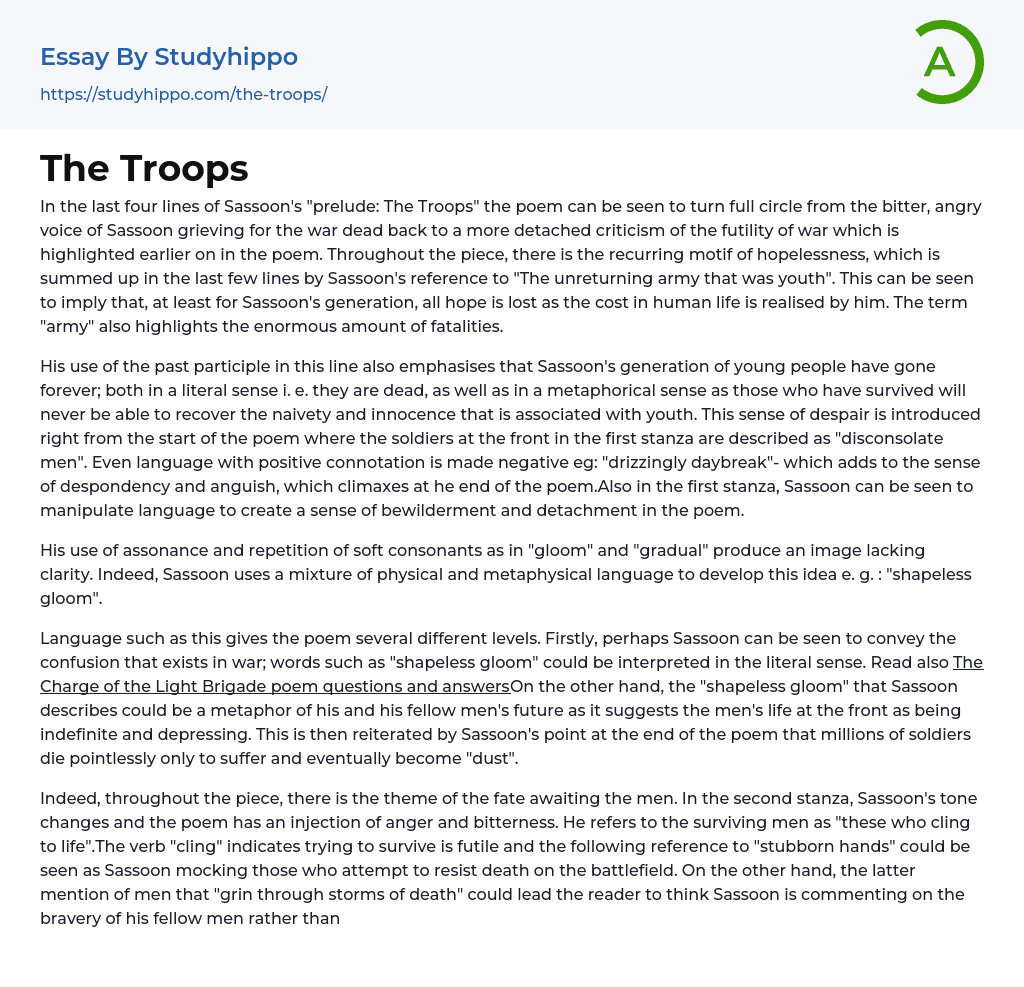In the last four lines of Sassoon's "prelude: The Troops" the poem can be seen to turn full circle from the bitter, angry voice of Sassoon grieving for the war dead back to a more detached criticism of the futility of war which is highlighted earlier on in the poem. Throughout the piece, there is the recurring motif of hopelessness, which is summed up in the last few lines by Sassoon's reference to "The unreturning army that was youth". This can be seen to imply that, at least for Sassoon's generation, all hope is lost as the cost in human life is realised by him. The term "army" also highlights the enormous amount of fatalities.
His use of the past participle in this line also emphasises that Sassoon's generation of young people have gone forever; both in a literal sense i.
...e. they are dead, as well as in a metaphorical sense as those who have survived will never be able to recover the naivety and innocence that is associated with youth. This sense of despair is introduced right from the start of the poem where the soldiers at the front in the first stanza are described as "disconsolate men". Even language with positive connotation is made negative eg: "drizzingly daybreak"- which adds to the sense of despondency and anguish, which climaxes at he end of the poem.Also in the first stanza, Sassoon can be seen to manipulate language to create a sense of bewilderment and detachment in the poem.
His use of assonance and repetition of soft consonants as in "gloom" and "gradual" produce an image lacking clarity. Indeed, Sassoon uses a mixture of physical
and metaphysical language to develop this idea e. g. : "shapeless gloom".
Language such as this gives the poem several different levels. Firstly, perhaps Sassoon can be seen to convey the confusion that exists in war; words such as "shapeless gloom" could be interpreted in the literal sense. Read also The Charge of the Light Brigade poem questions and answersOn the other hand, the "shapeless gloom" that Sassoon describes could be a metaphor of his and his fellow men's future as it suggests the men's life at the front as being indefinite and depressing. This is then reiterated by Sassoon's point at the end of the poem that millions of soldiers die pointlessly only to suffer and eventually become "dust".
Indeed, throughout the piece, there is the theme of the fate awaiting the men. In the second stanza, Sassoon's tone changes and the poem has an injection of anger and bitterness. He refers to the surviving men as "these who cling to life".The verb "cling" indicates trying to survive is futile and the following reference to "stubborn hands" could be seen as Sassoon mocking those who attempt to resist death on the battlefield. On the other hand, the latter mention of men that "grin through storms of death" could lead the reader to think Sassoon is commenting on the bravery of his fellow men rather than the hopelessness of their situation. Indeed, as the poem gathers pace through the use of the comma in the middle stanza, there is an infusion of nostalgia; "bird sung joy" and "grass-green thickets".
This perhaps can be seen to emphasise Sassoon's feeling of pride for his fellow men as well
as a sadness that they have left the safety of their beautiful country behind. This idea is echoed in the last four lines of the poem as he states his "companions" will travel to Valhalla. The idea of an ancient heaven for war heroes can be seen as an appropriate ending for the poem for various reasons. The sense of suffering of the soldiers as depicted in the first and middle stanzas "Haggard and hopeless" suggests these men deserve a special type of paradise fit only for soldiers.However, perhaps too, Sassoon is insinuating that they are now beyond a Christian type of afterlife as they have experienced such an unchristian event.
Certainly, by the end of the poem, the reader is made aware of Sassoon's stance on the First World War. From the beginning he creates an atmosphere of doom and hopelessness through language whilst suggesting he is bitter about his experience with war. These themes then culminate at the end of the poem with Sassoon's final references to the futility of war where men become "dust" as a result of it.
- Book Summary essays
- Metaphor essays
- Reader essays
- Rhyme essays
- Literary devices essays
- Villain essays
- Books essays
- Genre essays
- Literary Criticism essays
- Writer essays
- Protagonist essays
- Simile essays
- Poem essays
- Book Report essays
- Book Review essays
- Greek Mythology essays
- Plot essays
- Tragic Hero essays
- Coming of Age essays
- Play essays
- Rhetoric essays
- Rhetorical Question essays
- Translation essays
- Understanding essays
- Reason essays
- Character essays
- Letter essays
- American Literature essays
- Literature Review essays
- Utopia essays
- Poetry Analysis essays
- Dante's Inferno essays
- Between The World and Me essays
- Incidents in The Life of a Slave Girl essays
- Flowers for Algernon essays
- Myth essays
- Everyday Use essays
- Boo Radley essays
- Genesis essays
- Richard iii essays
- Alice in Wonderland essays
- On the road essays
- Ozymandias essays
- The Nightingale essays
- Holden Caulfield essays
- Animal Farm essays
- 1984 essays
- A Hanging essays
- Shooting An Elephant essays
- A Tale Of Two Cities essays




